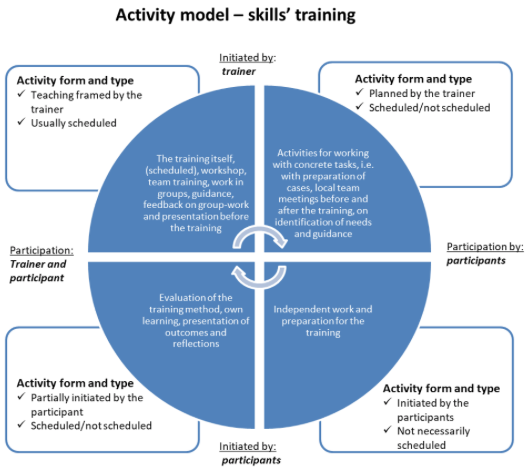Why This Domain?
When carrying out the actual training, you’ll need to consider different aspects to ensure maximal learning. This domain covers those areas and provides some potential ideas to help you achieve that aim.
What Should You Expect After Domain Completion?
You’ll have gained examples and specific guidance on how to execute the training successfully according to learning outcomes, the training programme, learner preparation, and more.
The Benefit?
Health & care professionals will enjoy more well-organised, streamlined training sessions. The expectations of both the training team and learners will be further aligned, underpinning progress towards the overall aim of improved innovation readiness, digital skills competencies, and implementation and change management skills.

Understanding and Achieving Learning Outcomes
- That learners through active participation in the training acquire knowledge, skills, and competencies to be able to act independently with respect to the department’s needs island the digital solution at hand
- That learners acquire competencies to take responsibility for their own work (and that of others) in relation to the given digital solution in complex work situations
- That learners through active participation in the training acquire knowledge, skills, and competencies to be able to independently propose new forms of use of the given digital solution for departments’ task solutions
- That learners share relevant knowledge and reflect together over the possibilities, challenges, and dilemmas related to the use of the digital solution
- This is possible via activity undertaken by both trainers and participants before, during, and after the training. You can use the activity model (see image above) to help plan the activities and illustrate various training activities directed at participants.
- Use practice-related cases inspired by the daily work undertaken by health & care professionals
- Centre the training on concrete technology that will (but has yet to) be used in clinical practice
- Ensure that skills are easily transferable to routine work
- Foster the sensation of support amongst participants during technology implementation and after the skills training
- Promote the plausibility of the training being a potential, prospective springboard for participants to reach agreements with other similar colleagues for future collaborations
- Determining the right setting(s) (simulation centres, e-Learning at work, nursing homes, etc.) according to resource allocation, time availability and health & care professionals’ needs could support desired training outcomes.
- Plan for follow-up activities, given that some participants (including citizens and patients) will still find trouble implementing the digital solution with the concrete technology
Defining A Training Programme That Delivers Results
- The session should last between 2-6 hours. Factors that will influence duration include the case in and of itself, complexity of the digital solution, and extent of training needs.
- The first half of the training should focus on when the digital solution is working and responsive. The second half should cover how to troubleshoot and address situations, in which the solution is unresponsive (not functioning properly).
- The recommended team size is 8-12 participants, as it promotes exchange of ideas and experiences and provides participants with the opportunity to formalize arrangements for the future.
- Clinical practice training could last 1-2 hours and include a short presentation about the specific technology, practical exercises, questions and answers, possible repetition of exercises and agreements on later follow-up.
- 2-3 short presentations (10 – 30 min) on varying topics at the beginning and during the day, e.g., technology development, the specific digital solution, and behavioural design and workflows.
- Concrete work with the digital solution via the use of hands-on exercises
- Group work on behavioural changes, organisational culture, and multidisciplinary collaboration
- Debriefing after each work done by the group
- Reflection and evaluation exercises throughout the day at an individual level. The evaluation should focus on the achievement of specific knowledge, skills, and competencies in relation to the technology to be used daily.
- A bridging of exercises with real-life scenarios
- A final evaluation for quality assurance purposes
Preparing The Participant
- Taking action before starting a training session could align expectations amongst all parties involved and maximise learning within the actual session. It will also let participants consider real examples from their settings beforehand, such as practical work remedies, and add more insight to the training discussions.
- Send a preparation sheet/email that introduces the following items: name of the training solution plus location and time; a checklist of what will be needed at the session; an additional checklist for health & care professionals to have the right login information; a summary of the learning objectives for that particular session; and a potential reference to what shift will be made in learning levels (see domain “Define the Learning Objectives and Outcomes” for more information).
